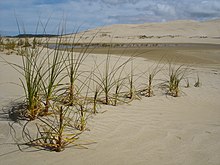Stolo


Stolons ( runners , singular stolo ) are attachments of eukaryotes such as plants , animals or fungi , which lead to cloning of two individuals with identical genetic information from one. This process is used for reproduction and is a form of autovegetative reproduction .
Stolons in plants
Some plant species develop elongated side shoots that creep either above or below the ground, starting from the base of the stem, the leaf rosette or the root neck. They are used for the vegetative (asexual) reproduction and spread of the plant and are a form of blastochoria . Roots and upright shoots can develop at the so-called nodes of the runners: If the connecting shoots then die, independent plants emerge, albeit genetically identical to the original plant.
Stolons occur in strawberries , for example .
Sprout tubers
From stolons also thickened (which can shoot tubers ) develop that as a storage volume with memory substrate for energy-rich sugars are used. Example is the potato .
Stolons in animals
Some moss animals form colonies by connecting individual units with stolons. Some colony-forming cnidarians develop from stolons of interconnected medusoid structures that later separate. Some types of Myrianida ( polychaete ) multiply by Schizogamie . Here, reproductive animals grow up as body appendages of a parent animal.
Stolons in mushrooms
In mycology , stolons are defined as occasionally separating hyphae that connect the sporangiophores together. Root-like structures, so-called rhizoids, can also appear on the stolo and anchor the hyphae to the substrate. Stolons are often found in bread mold and serve to spread them horizontally. This gave the common bread mold ( Rhizopus stolonifer ) its name.
The fossil Rangeomorpha , which may have spread via stolons, could be attributed to the fungi .
Foraminifera stolons
Furthermore, in orbitoidiform foraminifera, the connections between chambers are called stolons.
See also
- Offshoot (plant)
- Subsidence (offshoots) - shoots that take root in the earth
Individual evidence
- ↑ Jeffrey S. Levinton: Marine Biology. Oxford Press, 2008.
- ↑ Fredrik Pleijel: Polychaetous worm with engine and wagons . In: M. Hickey, C. King: The Cambridge Illustrated Glossary of Botanical Terms . Cambridge University Press, 2001.
- ↑ EC Mitchell, CG Kenchington, Ltd. Liu, JJ Matthews, NJ Butterfield: Reconstructing the reproductive mode of an Ediacaran macro-organism . In: Nature , Vol. 524, No. 7565, August 2015, pp. 343-346, doi : 10.1038 / nature14646 .
- ↑ Peterson et al., In: Integr. Comp. Biol., Vol. 43, 2003, pp. 127-136.
- ↑ Stolons. Retrieved January 21, 2019 .
